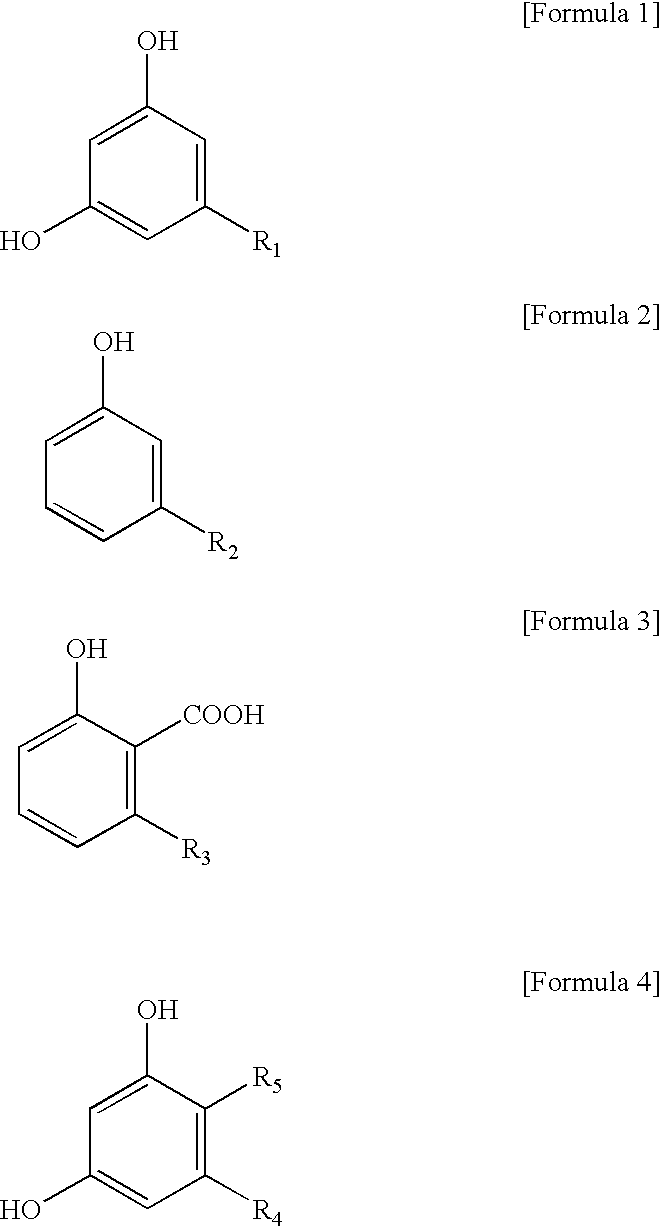Epoxy Resin, Epoxy Resin Composition Having the Same, Paint Composition and Method of Forming a Coating Layer Using the Same
a technology of epoxy resin and composition, which is applied in the direction of epoxy resin coating, liquid surface applicator, coating, etc., can solve the problems of poor water resistance and substantially retarded curing rate of epoxy resin composition, and achieve low viscosity, high working efficiency, and low viscosity
- Summary
- Abstract
- Description
- Claims
- Application Information
AI Technical Summary
Benefits of technology
Problems solved by technology
Method used
Image
Examples
synthetic example 1
[0054]A thermometer and a condenser were installed in a 2 L four-necked flask, and then the flask was placed on a stirrer and a heater. About 600 parts by weight of cardanol, about 740 parts by weight of epichlorohydrin and about 500 ppm of triethylammonium chloride used as a catalyst were added into the flask, and then the mixture was maintained at a temperature of about 80° C. under an atmosphere including nitrogen gas. About 90 parts by weight of an aqueous sodium hydroxide solution having a temperature of about 80° C. were dropped into the mixture for about 120 minutes. The aqueous sodium hydroxide solution contained 50% by weight of sodium hydroxide. Thereafter, the reaction was carried out for additional three hours. After the reaction finished, remaining and unreacted epichlorohydrin was heated and removed from the flask using a rotary evaporator under a lowered pressure. The reaction product was dissolved in about 200 parts by weight of toluene, and then was repeatedly washe...
example 1
[0055]A thermometer and a condenser were installed in a 4 L four-necked flask, and then the flask was placed on a stirrer and a heater. About 1,200 parts by weight of cardol, about 2,000 parts by weight of epichlorohydrin and about 500 ppm of triethylammonium chloride used as a catalyst were added into the flask, and then the mixture was maintained at a temperature of about 80° C. under an atmosphere including nitrogen gas. About 300 parts by weight of an aqueous sodium hydroxide solution having a temperature of about 80° C. were dropped into the mixture for about 120 minutes. The aqueous sodium hydroxide solution contained 50% by weight of sodium hydroxide. Thereafter, the reaction was carried out for additional three hours. After the reaction finished, remaining and unreacted epichlorohydrin was heated and removed from the flask using a rotary evaporator under a lowered pressure. The reaction product was dissolved in about 500 parts by weight of toluene, and then was repeatedly wa...
example 2
[0057]About 15 parts by weight of the epoxy resin prepared in Synthetic Example 1, about 10 parts by weight of trimethylolpropane triglycidyl ether, and about 75 parts by weight of a bisphenol-A epoxy resin having a weight-average molecular weight of about 380 were mixed at room temperature for about 30 minutes to thereby prepare an epoxy resin composition. The epoxy resin composition thus obtained had a liquid phase at room temperature, an epoxy equivalent of about 200 g / eq, and a viscosity of about 1,500 cps at a temperature of about 25° C. which was measured by a Brookfield LVII viscometer.
PUM
| Property | Measurement | Unit |
|---|---|---|
| temperature | aaaaa | aaaaa |
| temperature | aaaaa | aaaaa |
| temperature | aaaaa | aaaaa |
Abstract
Description
Claims
Application Information
 Login to View More
Login to View More - R&D
- Intellectual Property
- Life Sciences
- Materials
- Tech Scout
- Unparalleled Data Quality
- Higher Quality Content
- 60% Fewer Hallucinations
Browse by: Latest US Patents, China's latest patents, Technical Efficacy Thesaurus, Application Domain, Technology Topic, Popular Technical Reports.
© 2025 PatSnap. All rights reserved.Legal|Privacy policy|Modern Slavery Act Transparency Statement|Sitemap|About US| Contact US: help@patsnap.com

